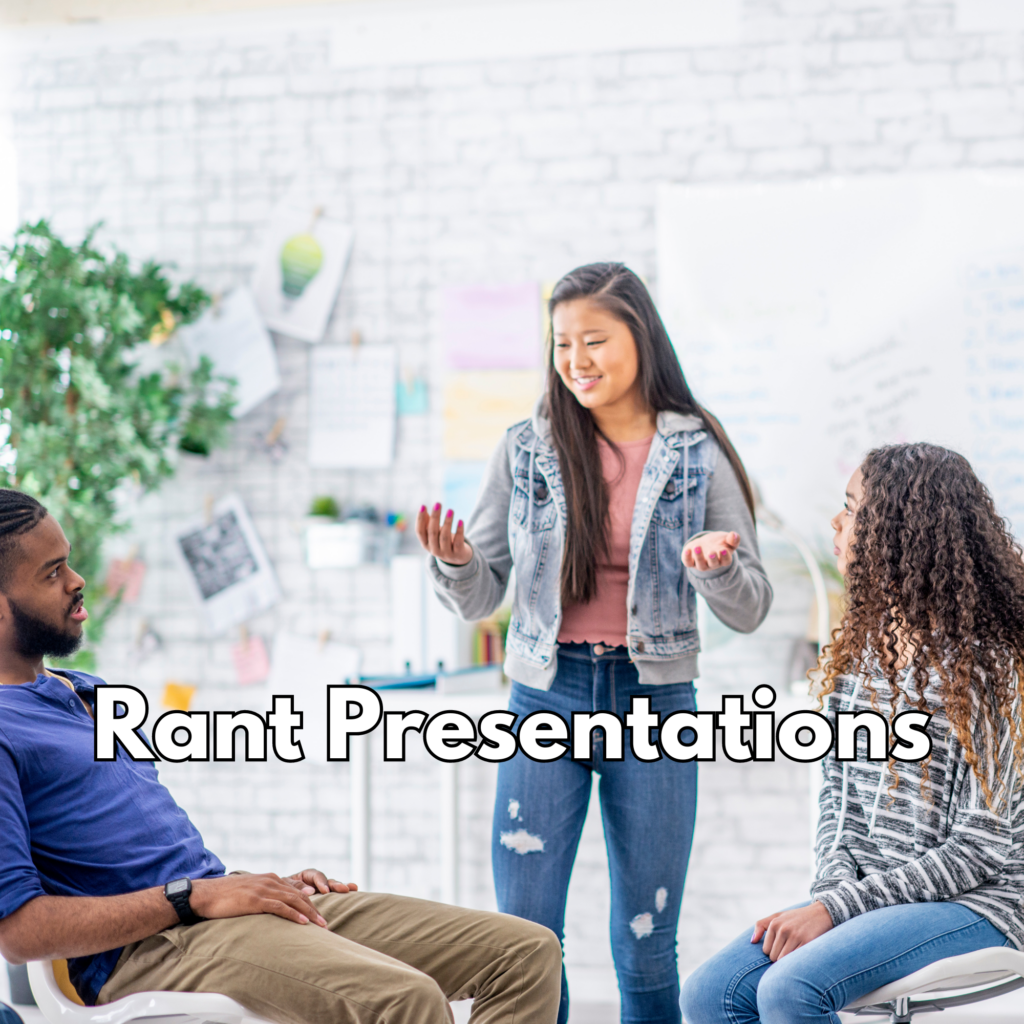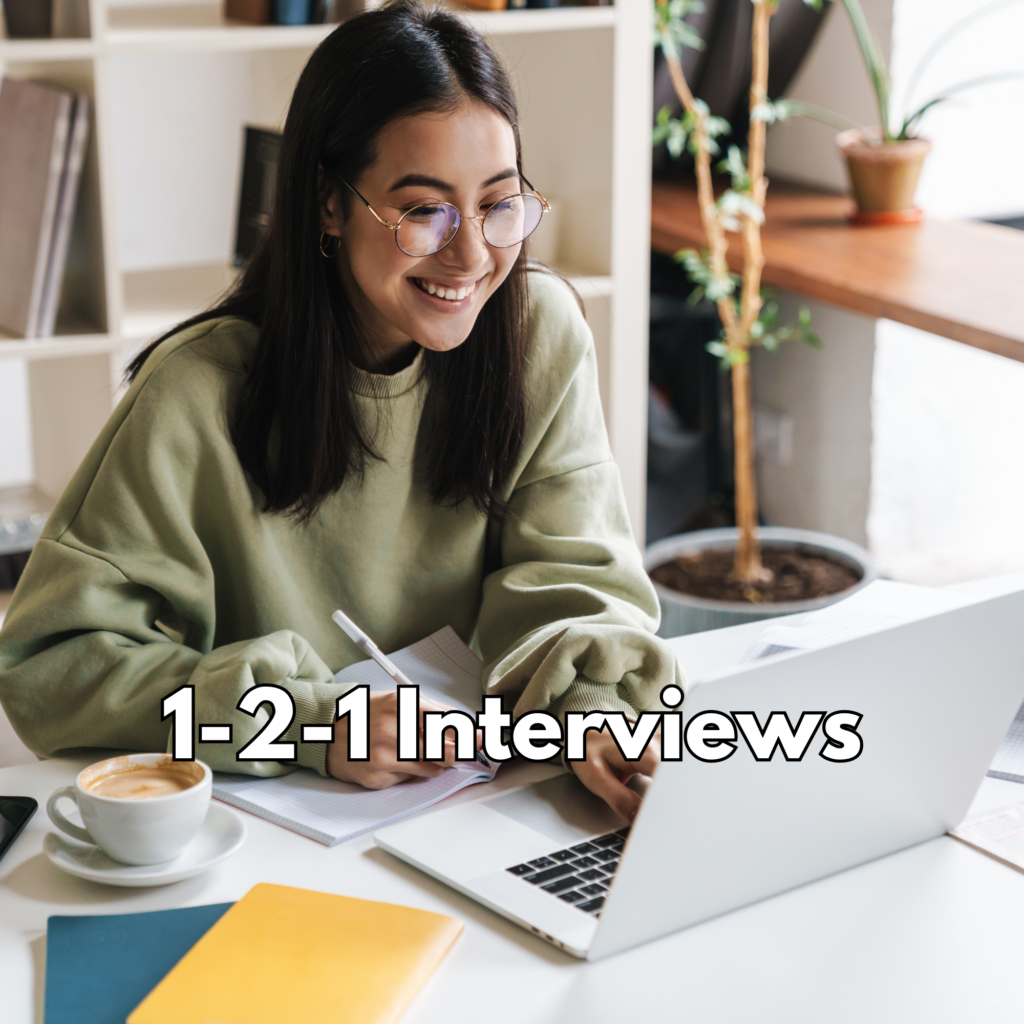Five Oral Presentation Alternatives That Will Get Your Students Talking
Sharing is caring!

We’ve all been there, trying to get our students to present their slideshows in front of the class, only to get a handful of mumblers, a few more confident speakers reading the slides verbatim, and a good portion of the class completely unwilling to regale their classmates with their topics. Speaking in front of people is hard, even for adults! While I do think there is merit in helping students gain the confidence and skills in public speaking, there are plenty of ways to get students using their oral communication skills that aren’t your traditional slide presentations.
I’m so thrilled to share the blog with four other talented ELA teacher-authors to bring you five oral presentation alternatives that will get your students talking.
1. RANT PRESENTATIONS

Kristy from 2 Peas and a Dog uses Rant Presentations to get students talking. Rants were made famous by Canadian comedian Rick Mercer. He would pick a current or trending topic and make a quick rant to share his thoughts.
Students have a lot to say and encouraging them to share their ideas in a constructive way is a win for both the teacher and the student. Students get to share their opinions with their peers and teachers get to assess their oral communication skills. You can try Rant Writing with your students with this free unit.
2. 1-2-1 INTERVIEWS

Lesa from SmithTeaches9to12 finds that many of her students will do just about anything to avoid oral presentations! And if we’re honest, devoting so many class periods to presentations means using time we just don’t ‘have’!
As a result, Lesa has tried a few alternatives to oral presentations. First, it’s to have students record their short presentations and upload to a shared set of slides. Students can then create a personalized playlist or the teacher can assign student X to watch slides 2, 4, 6 and student Y to watch 1, 3, 5, and so on. This can also be done in small groups with time for casual discussion after viewing. Note: My students never want to have their video shown to the same group they’re in so it’s worth polling students for their preference.
A second option is for the teacher to conduct 1-2-1 interviews with students. For a final project in grade 9 students had to create a movie poster for their chosen novel and then pitch the story, actors, and a tagline for the film. This was part of a larger overall project but this portion was completed first. This meant Lesa could be just outside the door and have a student present while the rest of the class worked on the next part of the assignment.
A final option is to have students interview each other either simultaneously with the teacher wandering to listen in or as a duo or even trio (like a talk show) at the front of the class. If done simultaneously this often looks more like a discussion than an interview. Meanwhile, the ‘talk show’ option allows students to get creative. Another year in grade 9 students created a movie poster and then had to conduct interviews with the author, lead(s) of the film, and/or director. This meant the lit circle group of 3-5 students each had a role in the interview and had key questions/points to address.
Find more teaching ideas on Lesa’s SmithTeaches9to12 website.
3. BRACKETOLOGY

Getting kids to talk in front of the class can be such a struggle. Krista from @whimsyandrigor knows that teachers and students don’t want to hear or give a presentation on a random topic just for the sake of getting a grade or addressing that standard.
So, she introduced a friendly little competition to get kids actually excited about talking in front of the class!
And bonus, because it’s about books!
Here’s the idea: students engage in an independent reading unit where they get to read, truly, whatever book they want.
Then they have to draft a 60-second speech that highlights a detail about a character, the plot, and/or the setting. They must include specific claims and back it up with evidence.
After practicing and receiving feedback, the books are placed in head-to-head competition. The class listens to each speech and completes a Google Form that asks them to rate each talk on: the effectiveness of the hook, the number of claims, relevant supporting evidence, speaking voice, and the last thing they say.
After hearing each person’s speech, the audience votes on which book should advance to the next round. But to ensure people don’t just vote for their BFFs, they have to give a specific reason why the speech was better. Krista, having the power of a teacher, also has a vote, but her vote counts as slightly more 🙂
Play continues in this way, with each vote advancing to the next round until an ultimate book is declared. With each round, the speeches become more nuanced and the speakers gain confidence. Plus, everyone is exposed to incredible books to add to their TBR!
If you want to enliven your public speaking unit, you can check out Krista’s full unit here for FREE!
4. PODCASTING

For many years, Katie from Mochas and Markbooks included a slide presentation as part of her culminating activity in order to account for the oral communication strand of the curriculum in her final 30% (culminating activity and exam). What she found however, was that students would simply create the slide presentation and turn it in without presenting it, or ask if they could present it to only her and not the class. Some students avoided making the slides altogether.
Knowing she needed to switch methods but not change the learning outcome, Katie landed on the idea of having her students record podcasts instead of speaking in front of their peers and it has been a complete success from only a handful of students finishing a slide presentation to every single student not only recording a podcast, but enthusiastically doing so, and going above and beyond what is asked to add cool sound effects, music, guests, and rehearsing their voices to sound more professional.
Katie has used podcast recording in a few different ways. She has assigned her students to create a podcast about an issue affecting Indigenous teens where they could interview their peers or elders (Katie’s high school is an Indigenous private school). She has also assigned a Book Talk podcast recording after her students finished reading the novel Moon of the Crusted Snow, and the podcasts turned out so good that she even sent some of them to the author, Waubgeshig Rice to listen to! He was very honored, he said.
If you’d like to follow the process Katie uses with your own students, you can check it out here.
5. PECHA KUCHA PRESENTATIONS

Students hate making presentations. As a result, they will often prepare slides and then simply read from them. Yawn. So what’s an English teacher to do? How about a Pecha Kucha Presentation? Jeanmarie from McLaughlin Teaches English first learned of Pecha Kucha from an online message board for English teachers. And she was surprised to discover that there is a subculture of people who gather for these specialized presentations.
A Pecha Kucha is a very stylized presentation that lasts exactly six minutes and forty seconds. It incorporates slides with images only, so no longer will have to listen and assess as students use their slides as giant note cards for their speeches. And these will be the best presentations that your students do all year long as not only will they not be able to read from their slides, but slides advance on their own after 20-seconds, so they must be precise and well planned.
For more on how to incorporate Pecha Kucha and other alternatives to having your students write essays, you can check out this post.
Which oral presentation alternatives have you tried with your students? Let us know in the comments or find us on Instagram to continue the conversation!

Leave a Reply Cancel reply
© Mochas and markbooks 2025 | Template by Waymaker Designs |